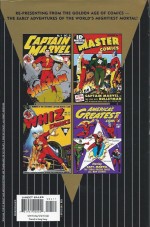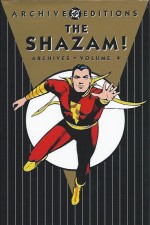

By William Woolfolk, C.C. Beck, Mac Raboy & various (DC Comics)
ISBN: 978-1-4012-0160-1
One of the most venerated and beloved characters of America’s Golden Age of comics, Captain Marvel was created in 1940 as part of a wave of opportunistic creativity which followed the stunning success of Superman in 1938.
Although there were many similarities in the early years, the Fawcett champion quickly moved squarely into the area of light entertainment and even straight comedy, whilst as the years passed the Man of Steel increasingly left whimsy behind in favour of action, drama and suspense.
Homeless orphan and good kid Billy Batson was selected by an ancient wizard to be given the powers of six gods and heroes to battle injustice. He transforms from scrawny precocious kid to brawny (adult) hero Captain Marvel by speaking aloud the wizard’s acronymic name – invoking the powers of legendary patrons Solomon, Hercules, Atlas, Zeus, Achilles and Mercury.
Publishing house Fawcett had first gained prominence through an immensely well-received light entertainment magazine for WWI veterans named Captain Billy’s Whiz-Bang, before branching out into books and general interest magazines. Their most successful publication – at least until the Good Captain hit his stride – was the ubiquitous boy’s building bible Mechanix Illustrated and, as the decade unfolded, the scientific and engineering discipline and can-do demeanour underpinning MI suffused and informed both the art and plots of the Marvel Family titles.
Captain Marvel was the brainchild of writer/editor Bill Parker and brilliant young illustrator Charles Clarence Beck who, with his assistant Pete Costanza, handled most of the art on the series throughout its stellar run. Before eventually evolving his own affable personality the full-grown hero was a serious, bluff and rather characterless powerhouse whilst junior alter ego Billy was the true star: a Horatio Alger archetype of impoverished, bold, self-reliant and resourceful youth overcoming impossible odds through gumption, grit and sheer determination…
After homeless orphan newsboy Billy was granted access to the power of legendary gods and heroes he won a job as a roaming radio reporter for Amalgamated Broadcasting and first defeated the demonic Doctor Thaddeus Bodog Sivana, setting a pattern that would captivate readers for the next 14 years…
At the height of his popularity Captain Marvel was published twice-monthly and outsold Superman, but as the Furious Forties closed tastes changed, sales slowed and Fawcett saw the way the wind was blowing. They finally settled an infamous, long-running copyright infringement suit begun by National Comics in 1940 and the Big Red Cheese vanished – as did so many superheroes – becoming little more than a fond memory for older fans…
Fawcett in full bloom, however, was a true publishing innovator and marketing powerhouse – and regarded as the inventor of many established comicbook sales tactics we all take for granted today. In this fourth magnificent deluxe full-colour hardback compendium we can see one of their best manoeuvres at play as the company responsible for creating crossover-events invented a truly unforgettable villain, set him simultaneously loose on a range of costumed champions and used his (temporary) defeat to introduce a new hero to their colourful pantheon.
Spanning the fraught yet productive period October 31st 1941 to May 13th 1942 and collecting in their entirety Captain Marvel Adventures #4-5, exploits from Master Comics #21-22, an adventure from fortnightly Whiz Comics #25 and another from anthology America’s Greatest Comics #2 – plus all the stunning covers by Beck and Raboy – this splendid compendium kicks off with an erudite and incisive Foreword by P.C. Hammerlinck (artist, editor, historian and former student of C.C. Beck) who reveals many secrets of the original comics’ production before the cartoon classic commences.
Although there was increasing talk of inevitable war amongst the American public at the time, most of these tales were created before Japan’s attack on Pearl Harbor, making the role of Adolf Hitler as a recurring villain and the creation of Captain Nazi in those by-no-means certain days acts of prophetic calculation…
However, as the thinly-veiled saboteur and spy sagas which previously permeated the genre until official Hostilities were finally established gave way to certainty, the Axis became the overarching threat of many comicbook heroes and this tome re-presents some of the very best clashes between exactingly defined polar opposites.
Of more interest perhaps is that at this period the stories – many of them still sadly uncredited – largely portray Marvel as a grimly heroic figure not averse to slaughtering the truly irredeemable villain and losing no sleep over it…
In those formative years, as the World’s Mightiest Mortal catapulted to the first rank of superhero superstars, there was actually a scramble to fill pages and, just as CMA #1 had been farmed out to up-and-coming whiz-kids Joe Simon & Jack Kirby, these first two solo issues were rapidly compiled by anonymous scripters under the guiding hand of veteran Jack Binder (whose brother Otto would soon become the assorted Marvels’ definitive scripter), another rising star who drew the issues in a hurry, working from Beck and Parker’s style guides.
The first of those uncredited issues is Captain Marvel Adventures #4 (October 31st 1941) with possible authors including Parker, Rod Reed, Joe Millard, Manly Wade Wellman, Otto Binder and William Woolfolk, whilst the Jack Binder Studio consisted of the man himself plus neophyte artists and recent graduates from Pratt Institute including young Bob Butts and Bill Ward.
‘Sivana’s Revenge’ kicks things off with a return engagement for the Three Lieutenant Marvels (a trio of other kids named Billy Batson who somehow shared the magic of Shazam’s gift). Fat Billy, Tall Billy and Hill Billy were visiting their namesake when the Devil Doctor repeatedly attempted to murder the radio reporter before seemingly losing his life in the detonation of a trap consisting of one million tons of dynamite…
The next tale introduced Hitler as the German-accented “warlord†of an aggressor nation which used slave labour from conquered European countries to dig ‘The Tunnel of Invasion’ right into the heart of Florida. Upon discovering the plot Marvel helped complete the project… but only so that he could trap the entire Nazi army at the bottom of the Atlantic.
‘The Secret Submarine Base’ found Billy investigating a murder and wrecking a scheme by sinister Mr. Fog to hide ambushing U-Boats in South America before calling in his adult alter ego to smash the site. Thereafter he teamed up with crusading DA Shaw to destroy the criminal empire of mobster Giggy Golton and his band of merciless assassins ‘The Lawless Legion’…
Captain Marvel Adventures #5 (December 12th) was communally illustrated by Beck’s “Fawcett Captain Marvel Art Staff†– which generally comprised Costanza, Marc Swayze, Pete Riss and Kurt Schaffenberger amongst others – opening with a stunning recap ‘Frontispiece’ before Sivana again rears his gleaming evil-stuffed head to perpetrate ‘Captain Marvel’s Double Trouble’ wherein a refugee princess is kidnapped by a boxer the wily genius has transformed through surgery. He’s still no match for the real deal though…
Nor is the volcano-making ‘King of the Crater’ who attempts to turn America into a bubbling ring of fire until Billy and the Captain spectacularly upset his engineering applecart, after which a reclamation project is saved from sabotage by a cunning mastermind and an aquatic monster when ‘Captain Marvel Solves the Swamp Mystery’…
The issue ends with another bout of weird science as ‘Sivana’s Strange Chemical Potion’ transforms people into completely different… people!
When Billy is replaced by a new kid with no memory of the power of Shazam, it takes fate in the form of a bunch of kids playing Captain Marvel to release the hero and unleash justice…
Bulletman – ably assisted by his companion Bulletgirl – was undoubtedly Fawcett’s second – if lesser – leading light, with his own solo comicbook and the star spot in monthly Master Comics. However, that all changed with issue #21 (December 1941) and ‘The Coming of Captain Nazi’ by William Woolfolk & Mac Raboy. In the rousing tale Hitler and his staff despatch their newest weapon – a literal Ãœbermensch – to spread terror and destruction in America and kill all its superheroes.
The murdering braggart gets right to work in New York City and soon Bulletman meets Captain Marvel as they both strive to stop the Fascist Fiend from wrecking the town and slaughtering innocents. The astounding battle – gracefully and immaculately rendered by Alex Raymond-inspired Raboy – only results in driving off the monster…
The saga picks up in Whiz Comics #25 (December 12th) with ‘The Origin of Captain Marvel Jr.’ (Woolfolk, Beck & Raboy) as the Nazi nemesis attempts to destroy a monumental hydroelectric dam before once again being foiled and fleeing…
When the monster tries to smash a new fighter plane prototype Captain Marvel stops him, but whilst pursuing the maniac is not quick enough to prevent him murdering an old man and brutally crushing a young boy.
Freddy Freeman seems destined to follow his grandfather into eternity, but remorseful Billy takes the dying lad to Shazam’s mystic citadel where the old wizard saves the boy’s life by giving him access to the power of the ancient gods and heroes. Now he will live – albeit with a permanently maimed leg – and whenever he pronounces the phrase “Captain Marvel†he will become a super-powered invulnerable version of himself…
With the stage set the lad then rockets over to Master Comics #22 (January 1942) to join Bulletman and Bulletgirl in stopping a string of Captain Nazi-sponsored assassinations in ‘Dr. Eternity’s Wax Death’ (by Woolfolk & Raboy), victoriously ending with a bold announcement that from the very next issue (not included here, curses!) the mighty boy will be starring in his own solo adventures…
The merits of the ongoing court-case notwithstanding, Fawcett undeniably took some of their publishing cues from the examples of Superman and Batman. Following on from a brace of Premium editions celebrating the New York World’s Fair, National Comics had released World’s Finest Comics; a huge, quarterly card-cover anthology featuring a host of their comicbook mainstays in new adventures, and early in 1941, Fawcett produced a 100-page bumper comic dedicated to their own dashing new hero and the other mystery-men in their stable: Spy Smasher, Bulletman, Minute Man and Mr. Scarlet & Pinky and more.
This startling slice of World War II Wonderment concludes with a Captain Marvel yarn from America’s Greatest Comics #2 (February 11th – May 13th 1942).
‘The Park Robberies’, anonymously scripted but illustrated by Beck, Berg and the Fawcett Captain Marvel Art Staff, features Billy’s battle to stop and redeem a gang of underage muggers headed for prison or worse, with Captain Marvel going undercover as an ordinary beat cop, but is most noteworthy today for introducing comedy sidekick – and by today’s standards, appalling minority stereotype – Steamboat Bill, who saved the day when real hardboiled thugs took over the scam…
After a rash of complaints, Steamboat was dropped and didn’t resurface when DC acquired the Fawcett properties and characters in 1973. The revived series brought the Captain and his genial crew to a new generation in a savvy experiment to see if his unique charm would work another sales miracle during one of comics’ periodic downturns.
Re-titled Shazam! – due to the incontestable power of lawyers and copyright convention – the revived heroic ideal enjoyed mixed success and a live action TV series in his own unique world before being subsumed into the company’s vast stable of characters…
Notwithstanding, Captain Marvel is a true milestone of American comic history and a brilliantly conceived superhero for all ages. These magical tales again show why “The Big Red Cheese†was such an icon of the industry and proves that such timeless, sublime comic masterpieces are an ideal introduction to the world of superhero fiction: tales that cannot help but appeal to readers of every age and temperament…
© 1941, 1942, 2003 DC Comics. All Rights Reserved.
